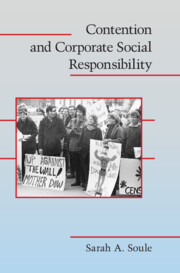Book contents
- Frontmatter
- Contents
- Figures
- Tables
- Preface
- 1 INTRODUCTION
- 2 UNDERSTANDING SOCIAL MOVEMENTS, CONTENTIOUS AND PRIVATE POLITICS, AND THEIR CONSEQUENCES
- 3 ANTICORPORATE PROTEST IN THE UNITED STATES, 1960–1990
- 4 THE EFFECT OF PROTEST ON UNIVERSITY DIVESTMENT
- 5 PRIVATE AND CONTENTIOUS POLITICS IN THE POST-1990 ERA
- 6 CONCLUSION
- Appendix A Description of Data Used in Chapter 3
- Appendix B Modeling Technique Used in Chapter 3
- Appendix C Sources of Data for Analysis in Chapter 4
- Appendix D Modeling Technique Used in Chapter 4
- Bibliography
- Index
3 - ANTICORPORATE PROTEST IN THE UNITED STATES, 1960–1990
Published online by Cambridge University Press: 05 June 2012
- Frontmatter
- Contents
- Figures
- Tables
- Preface
- 1 INTRODUCTION
- 2 UNDERSTANDING SOCIAL MOVEMENTS, CONTENTIOUS AND PRIVATE POLITICS, AND THEIR CONSEQUENCES
- 3 ANTICORPORATE PROTEST IN THE UNITED STATES, 1960–1990
- 4 THE EFFECT OF PROTEST ON UNIVERSITY DIVESTMENT
- 5 PRIVATE AND CONTENTIOUS POLITICS IN THE POST-1990 ERA
- 6 CONCLUSION
- Appendix A Description of Data Used in Chapter 3
- Appendix B Modeling Technique Used in Chapter 3
- Appendix C Sources of Data for Analysis in Chapter 4
- Appendix D Modeling Technique Used in Chapter 4
- Bibliography
- Index
Summary
In Chapter 1 I argued that in the United States there has always been some level of distrust of big business and corporations and that throughout our history, this distrust has periodically manifested itself in protest against these entities. While historically anticorporate protest has often been directed at the government with the goal of increasing regulation, or channeled through organized labor, it has been a pretty consistent facet of U.S. history. When we consider all protest in the United States reported in the New York Times between 1960 and 1990, we see that nearly 18% of public protest events targeted one or more business interest, sometimes alongside other targets, such as the government, religious organizations, or educational institutions. Figure 3.1 shows how the proportion of anticorporate protest varied by year during this period.
Figure 3.1 shows a dramatic peak in 1960–1961, when about 40% of all reported protest events targeted business interests. The bulk of these were associated with sit-ins at restaurants and department store lunch counters, as well as protest events staged in sympathy or as an expression of solidarity for the participants of the sit-ins.
Throughout the 1960s, we see a decline from this early peak, but in the late 1960s and early 1970s, we see this trend reverse, as protesters began to target companies making weapons used in the Vietnam War.
- Type
- Chapter
- Information
- Contention and Corporate Social Responsibility , pp. 53 - 79Publisher: Cambridge University PressPrint publication year: 2009



